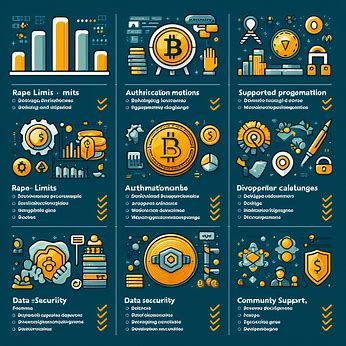Trading fees can eat into your margins, and over time, even small differences in fees can add up to significant amounts. That’s why finding the cryptocurrency exchanges with the lowest fees is crucial for high-volume traders looking to optimize their returns.
Binance
Binance is one of the world’s largest cryptocurrency exchanges and is a popular choice among high-volume traders. The exchange offers some of the lowest trading fees in the industry, starting at just 0.1% for makers and takers.
Binance exchange uses its native BNB token to offer significant discounts on trading fees. If you pay your fees in BNB, you can get a 25% discount, bringing the effective trading fee down to just 0.075%.
In addition to low fees, Binance offers high liquidity across a wide range of trading pairs. The exchange supports over 500 cryptocurrencies, making it a one-stop-shop for many traders.
Binance also offers advanced trading features, such as margin trading, futures trading, and options trading. These features, combined with the exchange’s low fees, make it a compelling choice for high-volume traders.
However, it’s worth noting that Binance has faced regulatory scrutiny in several jurisdictions. The exchange has taken steps to improve its compliance, but regulatory risk is something to be aware of.
Kraken
Kraken is another popular exchange among high-volume traders, known for its low fees and advanced trading features. The exchange uses a maker-taker fee model, with fees ranging from 0% to 0.26% depending on your 30-day trading volume.
Like Binance, Kraken offers discounts for high-volume traders. If your 30-day volume exceeds $10 million, you can qualify for maker fees as low as 0% and taker fees as low as 0.10%.
Kraken also offers a range of advanced trading features, including margin trading, futures trading, and OTC (over-the-counter) trading for large orders. The exchange’s user interface is designed for professional traders, with advanced charting and order types.
In terms of security, Kraken has a strong reputation. The exchange keeps 95% of user funds in cold storage and has never been hacked. It also offers two-factor authentication and a host of other security features.
Also Read: What is Dollar-Cost Averaging? A Beginner’s Guide
One potential drawback of Kraken is that it supports fewer cryptocurrencies than some other exchanges. But it covers all the major coins and has good liquidity on its supported trading pairs.
Huobi Global
Huobi Global is a major cryptocurrency exchange that offers competitive fees and a wide range of features. Like many exchanges, it uses a maker-taker fee model, with fees starting at 0.2% for both makers and takers.
However, Huobi offers significant discounts for high-volume traders. If your 30-day trading volume exceeds $5 million, you can qualify for maker and taker fees as low as 0.015%.
Huobi supports a wide range of cryptocurrencies, with over 400 supported coins. It also offers a variety of trading features, including margin trading, futures trading, and options trading.
In terms of security, Huobi has a good track record. The exchange uses cold storage for user funds and offers features like two-factor authentication and anti-phishing codes.
One unique feature of Huobi is its Huobi Eco Chain (HECO), a decentralized finance (DeFi) platform that allows users to participate in various DeFi projects. This can be an interesting option for traders looking to diversify their activities.
Bitstamp
Bitstamp is one of the oldest and most respected cryptocurrency exchanges. While its standard trading fees are relatively high (0.5% for makers and takers), it offers significant discounts for high-volume traders.
If your 30-day trading volume exceeds $10 million, you can qualify for maker fees as low as 0% and taker fees as low as 0.03%. This makes Bitstamp a compelling choice for very high-volume traders.
Bitstamp has a reputation for strong security. The exchange keeps 98% of user funds in cold storage and has mandatory two-factor authentication for all accounts.
important considerations
- Security: The safety of your funds should always be a top priority. Look for exchanges with strong security measures, such as two-factor authentication, cold storage, and a proven track record of safeguarding user assets.
- Liquidity: For high-volume traders, liquidity is key. You want to be able to enter and exit trades quickly and at the prices you want. Look for exchanges with high trading volumes and tight bid-ask spreads.
- Supported currencies: Make sure the exchange supports the cryptocurrencies you want to trade. While most major exchanges offer Bitcoin and Ethereum, support for lesser-known altcoins can vary.
- User interface: A clean, intuitive user interface can make a big difference in your trading experience. Look for exchanges with well-designed trading interfaces that offer the features and tools you need.
- Customer support: When issues arise, you want to be able to get help quickly. Look for exchanges with responsive customer support, preferably offering multiple contact methods.
While fees are important, they should be balanced against these other factors. The cheapest exchange isn’t necessarily the best if it compromises on security or has poor liquidity.
Tips for Minimizing Trading Fees
Regardless of which exchange you choose, there are several strategies you can use to minimize your trading fees:
- Use maker orders when possible. Maker orders, which add liquidity to the order book, often have lower fees than taker orders.
- Take advantage of fee discounts. Many exchanges offer discounts for high-volume trading, using the exchange’s native token, or holding certain amounts of cryptocurrency on the exchange.
- Consider using an exchange’s API for automated trading. Some exchanges offer lower fees for API trades.
- Be strategic about when you trade. Some exchanges have different fee tiers depending on the time of day or week.
- Keep an eye on fee structures. Exchange fees can change over time, so it’s important to periodically check that you’re still getting the best deal.
Frequently Asked Questions
1. What is a maker-taker fee model?
In a maker-taker fee model, the exchange charges different fees depending on whether your trade adds liquidity to the order book (a maker order) or takes liquidity from the order book (a taker order). Maker orders usually have lower fees than taker orders.
2. How can I qualify for high-volume trading discounts?
Each exchange has its own criteria for high-volume trading discounts. Typically, you need to exceed a certain trading volume over a 30-day period. The specific volume thresholds and corresponding fee discounts vary by exchange.
3. Are there any other ways to reduce trading fees besides high-volume discounts?
Yes, some exchanges offer discounts if you pay your fees in the exchange’s native token (like Binance’s BNB). Some also offer lower fees for API trading or for trading during certain times of the day or week.
4. How important is security when choosing a cryptocurrency exchange?
Security should be a top priority when choosing an exchange. Look for exchanges that keep a majority of user funds in cold storage, offer two-factor authentication, and have a strong track record of safeguarding user assets.
5. What should I do if my preferred exchange doesn’t support a cryptocurrency I want to trade?
If your primary exchange doesn’t support a particular coin, you may need to use a different exchange for that specific trade. However, be cautious about using unfamiliar exchanges, and always prioritize security.
6. Can I use the same exchange for both spot trading and derivatives trading?
It depends on the exchange. Some exchanges, like Binance and Kraken, offer both spot trading and derivatives trading (like futures and options). Others may specialize in one or the other.
7. How often should I reassess my choice of cryptocurrency exchange?
It’s a good idea to periodically review your choice of exchange, perhaps every 6-12 months, or whenever there are significant changes in the market or in exchange offerings. This ensures you’re always getting the best combination of fees, features, and security for your needs.








